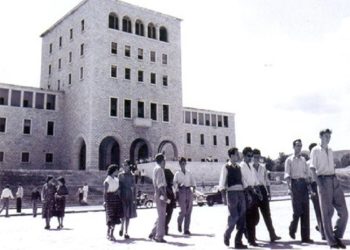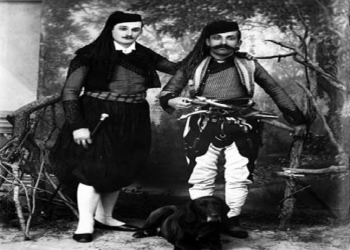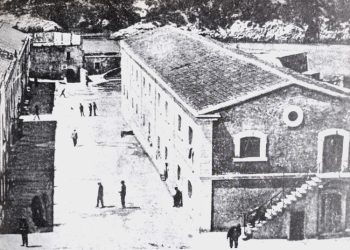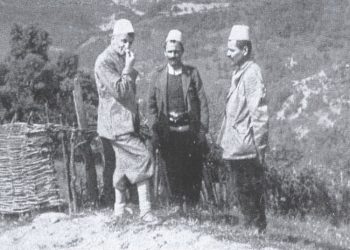Dashnor Kaloçi
Memorie.al brings the testimony of Isa Boletini, the hero’s nephew: “The revenge of the communist regime against our family began in 1943, when the Shkodra communists led by Vasil Shanto, assassinated Isa’s son and my father Adem Boletini. As a result, “of the policy pursued by communist Belgrade and Tirana, that after the murder of my grandfather in 1913, 15 people from our family were killed or executed and ten others spent years in prisons and internments.”
The revenge of the Slavo-communists against the well-known family of Isa Boletini began in November 1943, when the Shkodra communists led by Vasil Shanto assassinated my father, Lieutenant Colonel Adem Boletini, Isa’s third son who had graduated from the Military Academy in Vienna.
After that, both in Mitrovica, where most of the Boletins lived, and in Albania, our family found itself under a savage and barbaric persecution by the communist regimes of Tito and Enver Hoxha. From this unprecedented repression that was followed against the sons, grandsons and granddaughters of Isa Boletini, the number of killed and executed by our family reached 15 people and ten others suffered for years in the terrible prisons of Serbia and Albania. Enver Hoxha’s communist regime towards the Boletini family followed the same policy pursued by Tito’s communist regime for many years and as a result only in 1962, Isa Boletini was awarded the high title of People’s Hero. Even after that our family only once had an official invitation to go to Vlora on the anniversaries of the day of raising the Flag and in 1981 when the monument of my grandfather Isa Boletini was inaugurated in Shkodra, our family was not called, telling us that had forgotten “. Testifies for Memorie.al, Isa Boletini, (Isa Boletini’s grandson) former Physical Education teacher, Master of Sports and international volleyball referee, who recounts how his family was treated like by the communist regime of Tito In Yugoslavia, as well as that of Enver Hoxha in Albania, how did the revenge of the communist regime in Tirana on Isa Boletini’s family begin and who were the victims of that family who were executed, killed, imprisoned and interned at the instigation of Belgrade’s official policy? Regarding these and other facts from the tragic history of the Boletini family, we know the story of his young nephew Isa Boletini, who felt the heavy weight of the violence of the communist regime of Enver Hoxha on his shoulders. s.
GENOCIDE ON BULLETINS
What is the truth about the murder of Isa Boletini’s son by the Shkodra communists in 1944 and what was the attitude of the communist regime towards this family after the end of the war? In this regard, the young Isa Boletini testifies: “The assassination of my father, Lieutenant Colonel Adem Boletini, was carried out on November 23, 1943 by the Shkodra communists led by Vasil Shanto. and the Communist Party in Albania, as a sign of revenge against my grandfather Isa Boletini who fought for years against the Serbo-Montenegrins. At that time Adem’s murder was received with great indignation by all the people of Shkodra who condemned that barbaric act , because Adem Boletini served as a military man and was never involved in politics. Although I was not more than nine years old, I remember very well the magnificent funeral that the people of Shkodra gave to my father Adem, where the Antifascist youth of the city was forced and brought her crown. From that time, to cover up that crime and the great indignation of the people of Shkodra, the communists opened up that Adem Boletini had allegedly been killed unintentionally and the target of the assassination had been Major Ndrec Prenga, Commander of the Shkodra Gendarmerie. The same thing was rejected by the same two treatises that they rejected immediately after that murder. Of those two tracts, I remember as now only the first one we could find, where the murder of the father was talked about only in the last two lines. It said: “Adem Boletini was not sentenced to death by the SNP, but his stay with Major Ndrec Prenga was unjustified”, Isa Boletini recalls about the murder of his father Adem, who was also the third son of Isa Boletini.
CALVAR OF BULLETINS IN ALBANIA
The attitude of the communist regime of Tirana after 1944 towards the family of Adem Boletini’s son, showed best that the murder of Adem Boletini had been premeditated by them and not wrongly as they tried to present it. Isa Boletini recalls: “If the execution of our father Adem was not enough, the communist regime that came to power in 1944, driven by the official policy of Belgrade, continued to take revenge on Isa Boletini’s family. Thus in 1947 my mother Adile Bekteshi was arrested. who suffered for five years in the prisons of communist hell, where from bad conditions she got and some diseases which were not shared until she died? The imprisonment of my mother by the communists came as a result of the fact that her sister was the wife of Jup Kazazi , one of the most famous anti-communists who organized an armed revolt aimed at overthrowing the communist regime in 1947. After the conviction of our mother, the court decided to seize the property, although we had no property and lived in Shkodra. to the house of my uncle, the well-known doctor Dr. Selaudin Bekteshi. ë we stayed hidden for a month and it took the intervention of our uncle Dr. Bekteshi to return the order given for our expulsion from Tirana. Even after that, the attitude of the communist regime towards our family has been elastic depending on the political conjunctures. So, there were many cases where I was fired from Education and sent to work as a laborer. Likewise, brother Enisi who could hardly graduate as a doctor (under the care of his uncle Dr. Bekteshi) after two years of night school, although he was a well-known doctor, he was fired three times and sent to the morgue. The attitude of the communist regime towards our family changed only after the erection of the magnificent monument of Isa Boletini in the city of Shkodra in 1981, where at its inauguration our family was not called telling us that they had forgotten. “Also, during the entire period of the communist regime until 1990, our family was invited only once to participate in the anniversaries of the Declaration of Independence in Vlora, and after the 90s we were never invited”, he concludes his story Isa Boletini, adding that the assessment that Isa Boletini was not properly made by the communist regime in Albania, was made in Kosovo, where at the initiative of President Rugova himself, several scientific sessions were held and dozens of studies were published about his figure.
KILLED BY SERBS
Halil Boletini 1833
Mujë Boletini 1892
Ahmet Boletini 1894
Isa Boletini 1916
Halil Boletini 1916
Seid Boletini 1916
Jonuz Boletini 1916
Halit Boletini 1916
Musa Boletini 1944
Skënder Boletini 1944
Asllan Boletini 1945
Faik Boletini 1947
Isuf Boletini 1947
Rasim Dajçi (nip) 1945
Hysni Rudi (nip) 1945
PRISONERS IN YUGOSLAVIA
Mujë Boletini 3 vjet
Kapllan Boletini 20 vjet
Ali Boletini arrtisur nga burgu
Tafil Boletini burgosur në 1945
Ikbale Boletini burgosur në 1945
Kumrie Boletini burgosur në 1945
KILLED AND PRISONED IN ALBANIA
Adem Boletini vrarë në 1943
Tafil Boletini burgosur në 1945
Adile Boletini burgosur në 1947
Ismet Boletini burgosur në Spaç
Enver Dajçi (nip) burgosur në Spaç
The large family of Isa Boletini from Mitrovica, Kosovo
The early origin of the Boletini family, where the famous Isa Boletini comes from, is from the village of Isniq in Mitrovica. In that village that before the period of Skanderbeg is said to have lived their first called Lekë, who had three sons: Nika, Cana and Preka. From these three brothers who lived in the village of Isniq, three neighborhoods flowed and were created, which took the names: Niklekaj, Canalekaj and Preklekaj which were added and reached up to 500 houses. Like many large patriarchal families of that period, the Leka family and those who came after him for up to five generations, forced by Ottoman pressures and occupations and to avoid paying taxes and duties to Turkey, were placed in the children of their different names like Mujë, Demë, Hajdar and Myrsel. Thus, from the womb of Hajdari’s family and his brother Haliti, the Zhazhë neighborhood flowed and was created, while from the womb of the other brother Ahmeti, the Muslije neighborhood flowed and was created. The house of Ahmet and Isa Boletini flowed from Adem Myrseli. Later, increasing their number, about 180 houses were moved from the village of Isniq and settled around Istog where they formed the villages of Tomoe, Muzhevina, Prekalla, Rudica,
Zabllac, Trubuhovcë, Boletin e Zharcë. Also, at that time more than 50-60 other houses were moved from Isniqi which were settled in different villages and towns of Kosovo. According to a study by Prof. Skënder Luarasi, it is said that the first of this family, forced by the penetrations of the Ottoman invaders, came down from the northern areas where they lived at that time and settled in the village of Boletin around 1529, where they took the surname Boletini. This village, which is also the birthplace of Isa Boletini, is located not far from the city of Mitrovica (north of it) which looks like a small town located on the face of a large rock, next to a slope that the locals call Sokolaj. Around 1750, the towers of Boletin were burned for the first time by the camps of the Turkish army, when they marched towards that province to capture Hajdari of Deme Muja Nika and his brothers Halil and Ahmeti. Being like the Boletin tribe never agreed with the policy of the High Gate of Istanbul and was always at war with them, their towers in the village of Boletin were burned again in the years 1830-1832 when the Turkish army came to capture Adem Boletin. Likewise, in 1892 that tower was burned again by the Turks in the wars they waged against Ahmet Boletin. The story of the Boletini family continues with Isa Boletini (born in the village of Boletini on January 15, 1864) who continued the wars against the Turks and as a result, the fire on the towers of the Boletini was set again by Hafez Pasha who burned them in 1895 After that the towers of Boletin were burned twice in a row by the Young Turks in 1908 and 1914, in the wars they waged against Isa Adem Boletin. Isa Boletini had nine sons and five daughters, who were named: Halil, Zahid, Mujë, Adem, Musa, Bajazit, Asllan, Faik, Kapllan, Azize, Havize, Shehdije, Ajete and Feride. Isa Boletini after becoming one of the main leaders of Kosovo Albanians in their wars against the Ottoman occupation, one of the most famous events of his life, is the participation in raising the flag in Vlora in November 1912 where Ismail Qemali proclaimed Independence of Albania. Isa Boletini was killed by General Vukovibo’s Serbo-Montenegrin forces as he was crossing the Ribinica Bridge in the town of Podgorica. Along with Isa Boletini, seven members of his family were killed that day, starting with his eldest son Halili (24 years old), the other son Zahidi (18 years old) who was a student in Vienna at the time, two nephews Jonuzi (26 years old) and Halili (24 years old) as well as their three cousins named Hajdar Selim Radisheva, Misin Niman Bala and Idriz Bislimi. After the assassination of Isa Boletin in 1916, which coincided with the departure of the Ottoman army from Albania, the large Boletin family living in the village of the same name near Mitrovica, took over the administration of their property. In addition to these properties which consisted of agricultural land, livestock with thousands of sheep and pastures that stretched throughout the village of Boletin, the Boletini family has also been known for producing Madem stones for grinding mills, which were sold as far as Hungary. In 1944, with the coming to power of Tito’s communist regime, the Boletini family was subjected to savage and barbaric persecution, causing Isa Boletini’s sons, nephews and granddaughters to be persecuted, shot and imprisoned. The same thing happened with the rest of Isa Boletini’s family who were in Albania, where since 1943 Isa’s son, Lieutenant Colonel Adem Boletini was assassinated and then some of the nephews of this family suffered in prisons and internments. As a result of this policy pursued by the regimes of Belgrade and Tirana in the span of 80 years,15 people from Isa Boletin’s family were killed or executed and ten others suffered for years in prisons and internments. The communist regime of Tirana, following and holding the same attitude towards the Boletini family as that of Belgrade, did not give Isa Boletini the place he deserved in the History of Albania. As a result of this attitude, until 1962 he held only the order “Skanderbeg” and in that year, in the framework of the 50th Anniversary of Independence, he was awarded the high title “Hero of the People”. After that, about 20 years later in 1981, a magnificent monument was erected to him in the city of Shkodra and at his inauguration, the two nephews of Isa Boletini, Enisi and Isai, who lived in Tirana, were not called. /Memorie.al










